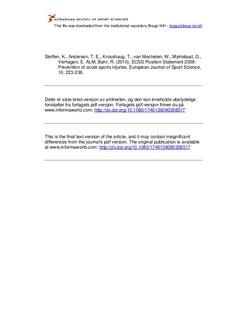| dc.contributor.author | Steffen, Kathrin | |
| dc.contributor.author | Andersen, Thor Einar | |
| dc.contributor.author | Krosshaug, Tron | |
| dc.contributor.author | van Mechelen, Willem | |
| dc.contributor.author | Verhagen, Evert A. | |
| dc.contributor.author | Bahr, Roald | |
| dc.date.accessioned | 2011-06-15T11:00:39Z | |
| dc.date.available | 2011-06-15T11:00:39Z | |
| dc.date.issued | 2010-06-09 | |
| dc.identifier | Seksjon for idrettsmedisinske fag / Department of Sports Medicine | |
| dc.identifier.citation | European Journal of Sport Science. 2010, 10(4), 223-236 | en_US |
| dc.identifier.issn | 1746-1391 | |
| dc.identifier.uri | http://hdl.handle.net/11250/170783 | |
| dc.description | I Brage finner du siste tekst-versjon av artikkelen, og den kan inneholde ubetydelige forskjeller fra forlagets pdf-versjon. Forlagets pdf-versjon finner du på www.informaworld.com: http://dx.doi.org/ 10.1080/1746139090358517 / In Brage you'll find the final text version of the article, and it may contain insignificant differences from the journal's pdf version. The original publication is available at www.informaworld.com: http://dx.doi.org/ 10.1080/1746139090358517 | en_US |
| dc.description.abstract | To maximize the health benefits of sports and exercise and to minimize the direct and indirect costs associated with injuries, developing and adopting injury prevention strategies is an important goal. The aim of this ECSS consensus paper on injury prevention is to review current evidence on injury prevention methods and training programmes aimed at reducing the most common or severe types of acute injuries. The target audience is everyone involved in protecting the health of the athlete, including coaches, referees, medical staff, sports governing bodies, as well as athletes themselves. Effective sports injury prevention requires successful implementation of efficacious interventions. This paper reviews the main mechanisms and risk factors for acute injuries to the head, shoulder, elbow, hand/wrist, groin, thigh, knee, and ankle, as well as the evidence supporting various strategies to prevent them. Approaches that have been shown to be successful include: (1) using equipment designed to reduce injury risk, (2) adopting the rules of play, and (3) specific exercise programmes developed to reduce injury risk. Sports organizations should adopt available injury prevention strategies as part of their policies. | en_US |
| dc.language.iso | eng | en_US |
| dc.publisher | Routledge Taylor & Francis | en_US |
| dc.subject | athletic injuries | en_US |
| dc.subject | prevention | en_US |
| dc.subject | risk factors | en_US |
| dc.subject | injury mechanisms | en_US |
| dc.subject | safety equipment | en_US |
| dc.subject | exercise programmes | en_US |
| dc.subject | health policy | en_US |
| dc.title | ECSS Position Statement 2009: prevention of acute sports injuries | en_US |
| dc.type | Journal article | en_US |
| dc.type | Peer reviewed | en_US |
| dc.subject.nsi | VDP::Social science: 200::Social science in sports: 330::Other subjects within physical education: 339 | en_US |
| dc.source.pagenumber | 223-236 | en_US |
